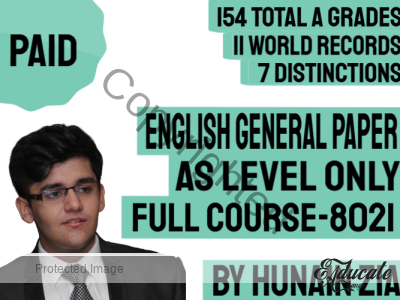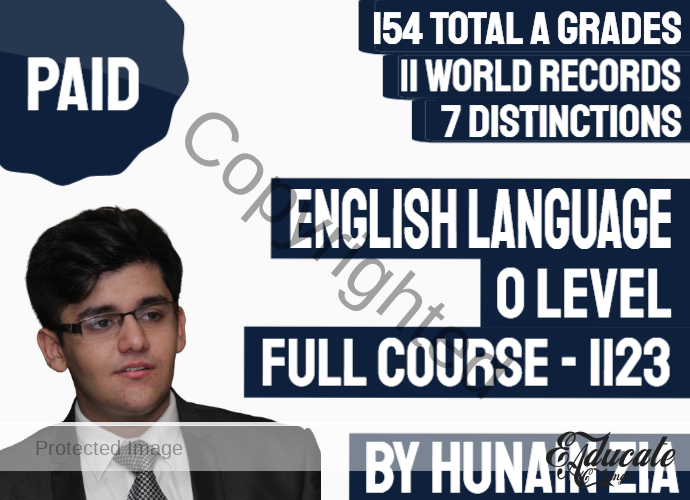English Language (1123) | O Level | Full-Scale Course
This Full-Scale course offers a complete online class for both the covering of the syllabus and the preparation for the examination. The Full-Scale is a tentative 2-4 months course, where the prime goal is to train a student from scratch to …
Overview
This Full-Scale course offers a complete online class for both the covering of the syllabus and the preparation for the examination. The Full-Scale is a tentative 2-4 months course, where the prime goal is to train a student from scratch to learn everything that they need to know for the examination. We incorporate a sophisticated strategy to target all the subject areas that are required to get the best grade possible. The course covers the complete syllabus of English Language (1123)- For O Level. The course has been designed to help any student, no matter how much they have prepared for the course. Students at all levels can benefit from the course. You are not required to buy any book to complement the course as it covers all that is required for a successful attempt at the subject. Also, being a crash course, the curriculum follows periodic content availability, just like a real classroom. However, the timing of the class does not matter: each student can take the class as per their own feasibility. Whenever new content is uploaded or is available, an announcement is made both on the course page, and communicated via e-mail to the students so that they may stay informed. Also, you may join later as the course allows for backward compatibility. Thus, a student joining in week 3 has access to the materials of week 1 and week 2, as well as limited ability to submit the assignments of these weeks. The curriculum shall be updated as the course progresses.
Ideally, the course contains:
- Complete lectures of Each Topic in A Unique Way
- Notes and Presentations
- Periodic Assignments with Proper Grading and Feedback
- Past Paper Based Quizzes
- Forum Access To Ask Any Question
- Complete availability of the Teacher.
- Best Resources and Guidelines
- Tip and Tricks for Paper Solution
- Paper Attempting Methodology for Best Grades
Curriculum
- 18 Sections
- 253 Lessons
- 32 Weeks
- Sample ContentSample Notes, Videos, Quizzes, Cheat Sheets, Assignments and Much More For Pre-Purchase Consideration.6
- Course Related InformationImportant Information Related To The Courses, Live Classes, Zoom Links etc.3
- Notes + Written Material For Contents of The SyllabusNotes for Chapters + Written Resources Regarding The Content66
- 3.1Use of Comma
- 3.2Sentence Structure
- 3.3Alternate Words to Use for Good To Describe A Place
- 3.4Alternate Words to Use for Good When Describing A Person
- 3.5Sample Story Written
- 3.6Paper 1 Tips and Tricks
- 3.7Paper 1 Tips and Tricks for Section B:
- 3.8Paper 2 Question 1
- 3.9Paper 2 Question 2
- 3.10Grammar: Tenses
- 3.11Grammar: Active and Passive Voice
- 3.12Demonstrate Understanding of Written Texts, And of The Words and Phrases Within Them
- 3.13Summarize And Use Material For A Specific Context
- 3.14Develop, Analyze and Evaluate Facts, Ideas and Opinions
- 3.15Develop, Analyze and Evaluate Facts, Ideas and Opinions
- 3.16Demonstrate Understanding of How Writers Achieve Their Effects And Influence Readers
- 3.17Select Appropriate Information For Specific Purposes
- 3.18Recognize And Respond To Linguistic Devices, Figurative Language and Imagery
- 3.19Reading Other Information
- 3.20Express What Is Thought, Felt And Imagined
- 3.21Organize and Convey Facts, Ideas and Opinions Effectively
- 3.22Demonstrate A Varied Vocabulary Appropriate To The Context
- 3.23Demonstrate An Effective Use of Sentence Structures
- 3.24Demonstrate An Understanding of Audience, Purpose and Form
- 3.25Demonstrate Accuracy In Spelling, Punctuation and Grammar
- 3.26Writing Other Information
- 3.27Grammar: Comma
- 3.28Grammar: Punctuation Marks
- 3.29Grammar: Sentence Structure
- 3.30Grammar: Figurative Language
- 3.31Writing: Tone and Register for Audience and Purpose
- 3.32Writing: Vocabulary Range
- 3.33Writing: Sentence Structure and Complex Sentences
- 3.34Writing: Assimilating Ideas and Writing In Well-Structured/ Organized Manner
- 3.35Writing: Developing Content, Fillers and Effectively Expanding Content
- 3.36Content: Selecting Wide Range of Ideas and Opinions
- 3.37Content: Analyzing And Evaluating Ideas
- 3.38Content: Narrative Features
- 3.39Content: Descriptive Features
- 3.40Vocabulary: Precise and Effective Range In Vocabulary
- 3.41Vocabulary: Complex Spelling
- 3.42Descriptions: Focus
- 3.43Descriptions: Atmosphere
- 3.44Descriptions: Direction
- 3.45Descriptions: Senses
- 3.46Descriptions: Contrast
- 3.47Descriptions: Setting and People Within The Setting
- 3.48Descriptions: Reactions of Observer
- 3.49Descriptions: Minimal or No Narrative Framework
- 3.50Descriptions: Figurative Language Techniques
- 3.51Descriptions: Sound Devices
- 3.52Descriptions: Linking Response For Cohesive Picture
- 3.53Narratives: Scenario Established At Beginning
- 3.54Narratives: Setting
- 3.55Narratives: Atmosphere
- 3.56Narratives: Senses
- 3.57Narratives: Figurative Language
- 3.58Narratives: Characterization of Protagonist
- 3.59Narratives: Control of Time Frame
- 3.60Narratives: Movement of Events
- 3.61Narratives: Build-Up Tension
- 3.62Narratives: Effective Climax
- 3.63Narratives: Anti-Climax
- 3.64Narratives: Cliff Hanger, Flashback And Other Techniques
- 3.65Lexical Group List For Writing
- 3.66Lexical Group List With Examples
- Video Lectures For The ContentVideo Lectures Covering Course Content In Detail3
- 4.1Lecture 1: Suffix Prefix, Phrasal Verbs, Compound WordsFigurative Language, Active and Passive Voice, Direct and Indirect Speech, , Quotation Marks, Homophones, Article, Degrees of Adjectives, Use of Apostrophe, , Common Subject Verb Issues, Tenses, Paper Planning for Narration, Use of Connectives, Sentence Structure (Simple, Compound and Complex Sentences), Subject/ Verb Agreement, Question Tag, Use of Comma, Oxford Comma, Development of Paragraph, The Concept of Topic Sentence, Narrative Techniques, The Use of Dialogue,3 Hours
- 4.2Lecture 2: Paper 1 and Paper 2 Complete Discussion + Specimen Paper1 Hour
- 4.3Detailed Paper Pattern and Attempt Methods
- QuizzesShort Quizzes To Auto-Test Your Knowledge of The Syllabus0
- Quizzes For PreparationQuizzes With Detailed Explained Answers And Common Mistakes Discussed In Detail61
- 6.1Use of Comma
- 6.2Sentence Structure
- 6.3Alternate Words to Use for Good To Describe A Place
- 6.4Alternate Words to Use for Good When Describing A Person
- 6.5Paper 1 Tips and Tricks
- 6.6Paper 1 Tips and Tricks for Section B:
- 6.7Paper 2 Question 1
- 6.8Paper 2 Question 2
- 6.9Grammar: Tenses
- 6.10Grammar: Active and Passive Voice
- 6.11Demonstrate Understanding of Written Texts, And of The Words and Phrases Within Them
- 6.12Develop, Analyze and Evaluate Facts, Ideas and Opinions
- 6.13Demonstrate Understanding of How Writers Achieve Their Effects And Influence Readers
- 6.14Select Appropriate Information For Specific Purposes
- 6.15Recognize And Respond To Linguistic Devices, Figurative Language and Imagery
- 6.16Reading Other Information
- 6.17Organize and Convey Facts, Ideas and Opinions Effectively
- 6.18Demonstrate A Varied Vocabulary Appropriate To The Context
- 6.19Demonstrate An Effective Use of Sentence Structures
- 6.20Demonstrate An Understanding of Audience, Purpose and Form
- 6.21Demonstrate Accuracy In Spelling, Punctuation and Grammar
- 6.22Writing Other Information
- 6.23Grammar: Punctuation Marks
- 6.24Grammar: Sentence Structure
- 6.25Grammar: Figurative Language
- 6.26Writing: Tone and Register for Audience and Purpose
- 6.27Writing: Vocabulary Range
- 6.28Writing: Sentence Structure and Complex Sentences
- 6.29Writing: Assimilating Ideas and Writing In Well-Structured/ Organized Manner
- 6.30Writing: Developing Content, Fillers and Effectively Expanding Content
- 6.31Content: Selecting Wide Range of Ideas and Opinions
- 6.32Content: Analyzing And Evaluating Ideas
- 6.33Content: Narrative Features
- 6.34Content: Descriptive Features
- 6.35Vocabulary: Precise and Effective Range In Vocabulary
- 6.36Vocabulary: Complex Spelling
- 6.37Descriptions: Focus
- 6.38Descriptions: Atmosphere
- 6.39Descriptions: Direction
- 6.40Descriptions: Senses
- 6.41Descriptions: Contrast
- 6.42Descriptions: Setting and People Within The Setting
- 6.43Descriptions: Reactions of Observer
- 6.44Descriptions: Minimal or No Narrative Framework
- 6.45Descriptions: Figurative Language Techniques
- 6.46Descriptions: Sound Devices
- 6.47Descriptions: Linking Response For Cohesive Picture
- 6.48Narratives: Scenario Established At Beginning
- 6.49Narratives: Setting
- 6.50Narratives: Atmosphere
- 6.51Narratives: Senses
- 6.52Narratives: Figurative Language
- 6.53Narratives: Characterization of Protagonist
- 6.54Narratives: Control of Time Frame
- 6.55Narratives: Movement of Events
- 6.56Narratives: Build-Up Tension
- 6.57Narratives: Effective Climax
- 6.58Narratives: Anti-Climax
- 6.59Narratives: Cliff Hanger, Flashback And Other Techniques
- 6.60Lexical Group List For Writing
- 6.61Lexical Group List With Examples
- AssignmentDetailed Assignments For Syllabus Preparation (Including Past Paper Questions)7
- Paper Pattern/ Paper Preparation/ Techniques To Attempt The Paper/ Common Mistakes To Avoid0
- Solved Past PapersDetailed Written Explanations And Solutions of Past Papers, Including Model Answers and Explanations For Past Paper Questions1
- Past Paper SessionVideo Content Regarding Past Paper Solutions2
- Notes (Rearranged Version)Notes Arranged In A Different Style For Preparation Ease0
- Videos Lectures (Pre-Recorded)Videos Recorded In A Different Style For Preparation Ease0
- Vocabulary Lists101
- 13.1Emotions & Feelings: Positive Emotions
- 13.2Emotions & Feelings: Negative Emotions
- 13.3Emotions & Feelings: Mixed/Complex Emotions
- 13.4Emotions & Feelings: Physical Responses To Emotions (E.G. Trembling, Flushed)
- 13.5Emotions & Feelings: Emotional Intensity Scale (E.G. Calm → Irritated → Furious)
- 13.6Personality & Character Traits: Positive Personality Traits
- 13.7Personality & Character Traits: Negative Personality Traits
- 13.8Personality & Character Traits: Neutral/Descriptive Personality Traits
- 13.9Personality & Character Traits: Words To Describe Introverts/Extroverts
- 13.10Personality & Character Traits: Leadership And Authority-Related Vocabulary
- 13.11Personality & Character Traits: Dishonest And Manipulative Behavior Words
- 13.12Physical Appearance: Facial Features
- 13.13Physical Appearance: Body Types And Shapes
- 13.14Physical Appearance: Hair Textures, Colors, And Styles
- 13.15Physical Appearance: Clothing And Dressing Vocabulary
- 13.16Physical Appearance: Posture And Movement (E.G. Slouched, Brisk)
- 13.17Actions And Behavior: Verbs For Movement (E.G. Sprint, Tiptoe, Stagger)
- 13.18Actions And Behavior: Gestures And Body Language
- 13.19Actions And Behavior: Speech Verbs (E.G. Murmur, Barked, Whispered)
- 13.20Actions And Behavior: Facial Expressions (E.G. Frown, Beam, Smirk)
- 13.21Actions And Behavior: Emotional Reactions (E.G. Flinched, Sighed)
- 13.22Adjectives By Category: Adjectives To Describe: Weather
- 13.23Adjectives By Category: Adjectives To Describe: Food And Taste
- 13.24Adjectives By Category: Adjectives To Describe: Sound
- 13.25Adjectives By Category: Adjectives To Describe: Texture
- 13.26Adjectives By Category: Adjectives To Describe: Smell
- 13.27Adjectives By Category: Adjectives To Describe: Color
- 13.28Adjectives By Category: Adjectives To Describe: Light And Darkness
- 13.29Adjectives By Category: Adjectives To Describe: Temperature
- 13.30Adjectives By Category: Adjectives To Describe: Emotions
- 13.31Adjectives By Category: Adjectives To Describe: Environments And Settings
- 13.32Environments And Settings: Adverbs Of Manner (E.G. Carefully, Urgently)
- 13.33Environments And Settings: Adverbs For Time And Sequence (E.G. Eventually, Immediately)
- 13.34Environments And Settings: Adverbs Of Frequency And Degree (E.G. Rarely, Extremely)
- 13.35Environments And Settings: Adverbs For Narrative Control (E.G. Suddenly, Silently)
- 13.36Vocabulary For Descriptive Writing: Nature And Landscapes
- 13.37Vocabulary For Descriptive Writing: Urban Settings
- 13.38Vocabulary For Descriptive Writing: Weather Phenomena
- 13.39Vocabulary For Descriptive Writing: Sounds And Silence
- 13.40Vocabulary For Descriptive Writing: Buildings And Structures
- 13.41Vocabulary For Descriptive Writing: Mood-Setting Words
- 13.42Vocabulary For Narrative Writing: Conflict And Tension
- 13.43Vocabulary For Narrative Writing: Victory And Failure
- 13.44Vocabulary For Narrative Writing: Danger And Safety
- 13.45Vocabulary For Narrative Writing: Surprise And Suspense
- 13.46Vocabulary For Narrative Writing: Internal Monologue Vocabulary
- 13.47Vocabulary For Narrative Writing: Flashback And Memory-Trigger Words
- 13.48Vocabulary For Summary Writing: Neutral/Formal Tone Vocabulary
- 13.49Vocabulary For Summary Writing: Reported Speech Verbs (E.G. Claimed, Argued, Warned)
- 13.50Vocabulary For Summary Writing: Grouping And Categorizing Phrases (E.G. Several Factors, Various Issues)
- 13.51Vocabulary For Summary Writing: Linking Expressions For Clarity And Flow
- 13.52Vocabulary For Summary Writing: Cause-Effect And Comparison Vocabulary
- 13.53Vocabulary For Directed Writing Tasks: Formal Letter Expressions
- 13.54Vocabulary For Directed Writing Tasks: Informal Letter Expressions
- 13.55Vocabulary For Directed Writing Tasks: Report Writing Vocabulary
- 13.56Vocabulary For Directed Writing Tasks: Speech And Article Tone Shifts
- 13.57Vocabulary For Directed Writing Tasks: Complaint/Suggestion/Feedback Language
- 13.58Vocabulary For Directed Writing Tasks: Polite Requests, Persuasive Tone Words
- 13.59Academic Vocabulary: Analytical Verbs (E.G. Evaluate, Infer, Contrast)
- 13.60Academic Vocabulary: Argument And Opinion Phrases (E.G. It Is Widely Believed, One Could Argue)
- 13.61Academic Vocabulary: Academic Connectors (E.G. Consequently, Moreover, Despite)
- 13.62Academic Vocabulary: Synonyms For Commonly Repeated Words (E.G. Important, Good, Bad, Big)
- 13.63Tone And Mood Words: Positive Tone (E.G. Optimistic, Enthusiastic)
- 13.64Tone And Mood Words: Negative Tone (E.G. Bitter, Resentful)
- 13.65Tone And Mood Words: Neutral/Ambiguous Tone
- 13.66Tone And Mood Words: Sarcastic, Ironic, Reflective Tones
- 13.67Tone And Mood Words: Melancholic, Nostalgic, Anxious Moods
- 13.68Describing Scenarios & Situations: Conflict/Accident/Emergency
- 13.69Describing Scenarios & Situations: Joyous/Festive Moments
- 13.70Describing Scenarios & Situations: Natural Disasters
- 13.71Describing Scenarios & Situations: School-Related Situations
- 13.72Describing Scenarios & Situations: Family/Home Dynamics
- 13.73Describing Scenarios & Situations: Social Events And Gatherings
- 13.74Weather & Nature Vocabulary: Calm Weather (E.G. Balmy, Serene)
- 13.75Weather & Nature Vocabulary: Violent Weather (E.G. Torrential, Howling)
- 13.76Weather & Nature Vocabulary: Natural Settings (E.G. Meadows, Cliffs)
- 13.77Weather & Nature Vocabulary: Natural Settings (E.G. Meadows, Cliffs)
- 13.78Sound, Light & Smell: Words For Sounds (E.G. Screech, Murmur, Clang)
- 13.79Sound, Light & Smell: Words For Light (E.G. Gleam, Glint, Flicker)
- 13.80Sound, Light & Smell: Words For Smells (E.G. Pungent, Aromatic, Musty)
- 13.81Colour Vocabulary: Common And Rare Color Shades
- 13.82Colour Vocabulary: Emotive Color Associations (E.G. Crimson For Anger)
- 13.83Colour Vocabulary: Color-Related Metaphors (E.G. Green With Envy)
- 13.84Vocabulary For Comparison And Contrast: Similarity And Difference (E.G. Likewise, In Contrast)
- 13.85Vocabulary For Comparison And Contrast: Degrees Of Comparison (E.G. Slightly, Significantly)
- 13.86Vocabulary For Comparison And Contrast: Comparison Of Qualities (E.G. Harsher, Brighter)
- 13.87Vocabulary To Avoid Repetition: Said
- 13.88Vocabulary To Avoid Repetition: Walk
- 13.89Vocabulary To Avoid Repetition: Look
- 13.90Vocabulary To Avoid Repetition: Happy
- 13.91Vocabulary To Avoid Repetition: Sad
- 13.92Vocabulary To Avoid Repetition: Big/ Small
- 13.93Vocabulary To Avoid Repetition: Good/ Bad
- 13.94Vocabulary To Avoid Repetition: Nice/ Beautiful
- 13.95Figurative Language & Sensory Vocabulary: Simile And Metaphor Examples
- 13.96Figurative Language & Sensory Vocabulary: Personification Words
- 13.97Figurative Language & Sensory Vocabulary: Onomatopoeic Vocabulary
- 13.98Figurative Language & Sensory Vocabulary: Five Senses Vocabulary Lists
- 13.99Vocabulary To Describe Time & Sequence: Time Shifts (E.G. Earlier, Later, Eventually)
- 13.100Vocabulary To Describe Time & Sequence: Narrative Sequencing (E.G. At First, Suddenly, After A While)
- 13.101Vocabulary To Describe Time & Sequence: Past, Present, Future Indicators
- Cheat SheetsShort, Quick Revision Cheat Sheets0
- Practice Questions/ Practice ExamsPractice Questions/ Exams Based Both On Actual Exam Pattern And On Topical Content To Boost Preparation And Improve Performance0
- Mock Tests/ Mock ExamsMock Exams For Final Preparation0
- Class RecordingsClass Recordings From Previous Sessions/ Current Session For Content0
- Other MaterialOther Useful Material For Exams4







